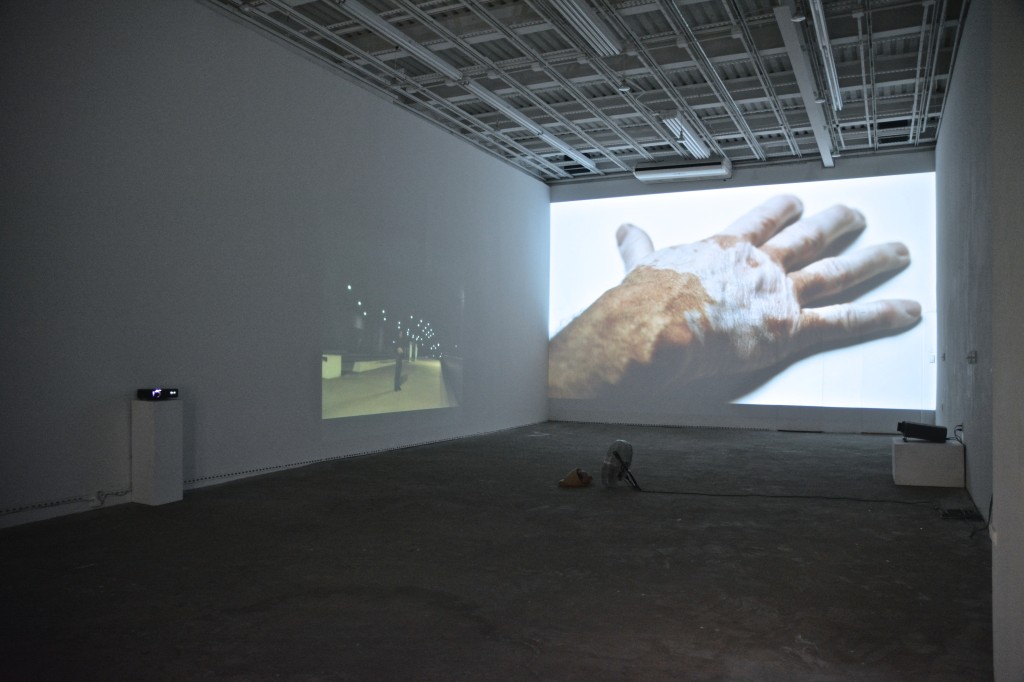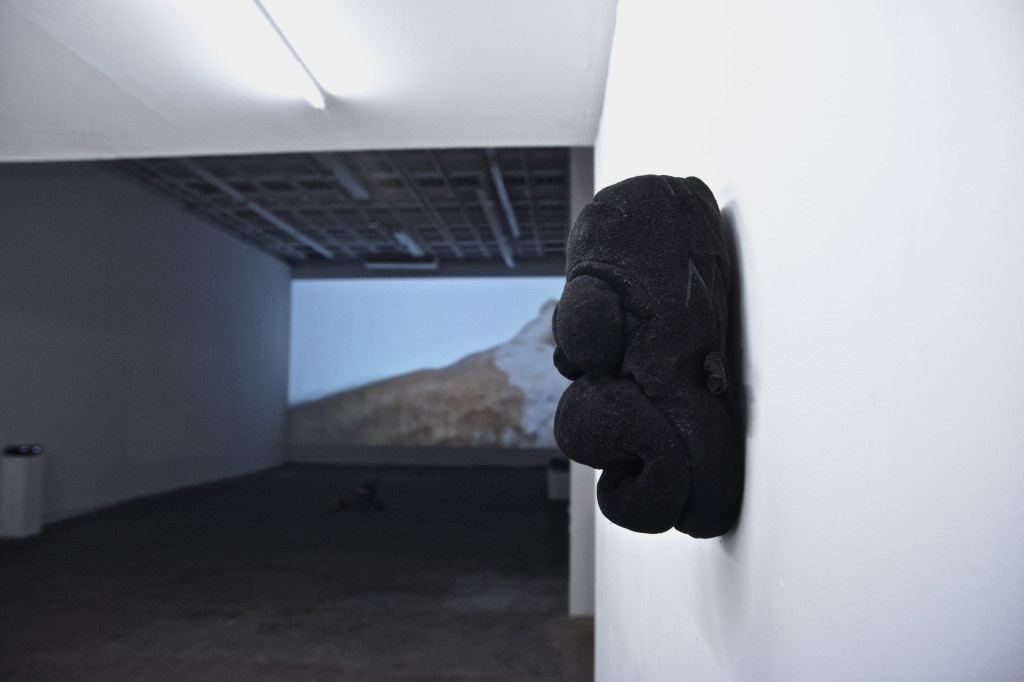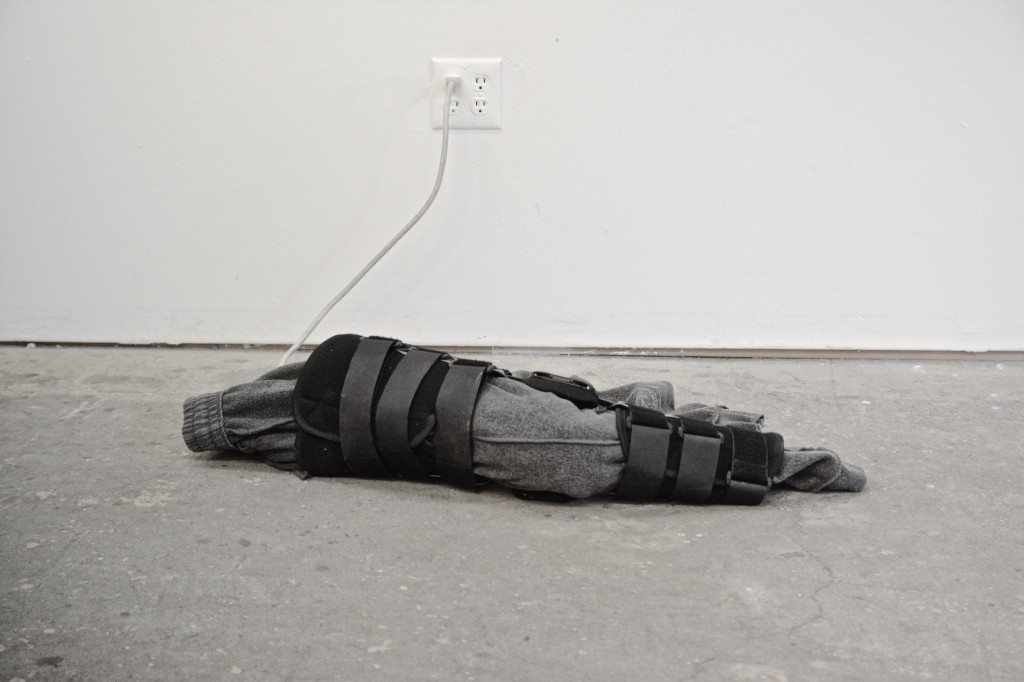
Piotr Skiba, Honky, WhiteBox Art Center, New York, exhibition view, courtesy of MAK Gallery, Photograph: Piotr Skiba.
We first met Piotr Skiba ten years ago, when we were invited to document a gallery show in Catskill, NY. Already, Skiba was integrating elements of performance and prepared objects into his painting practice, and we have been following his work ever since. We were particularly interested to see how his latest works continued this evolution into mixing media (if not exactly ‘mixed media’) as his show HONKY opened in New York at the Whitebox Art Center.
Whitebox is a long, thin gallery space, leading back from a narrow street frontage to a tennis court sized, high ceilinged main space. Skiba’s exhibition uses the particular architecture of this space to construct a pathway of images, projections, objects and sound installations which leads the visitor on a walk into a darkness.
We will try to describe these images in the order in which they are perceived by the visitor.
On a large monitor giving onto cobbled cross-street off the Bowery, on the Lower East Side of Manhattan – not a casual choice of venue – is what seems to be a still shot of a disembodied head lying on the ground. Only at the end of its one-minute loop do we realise this is in fact a video, abruptly shocked out of our contemplation when a foot appears and brutally kicks the head out of frame, leaving an emptiness. Also visible from the street, through the large glass doors, is a wall-sized projection of a man exploring his own face which turns out to be caught inside a detailed latex mask, a trope recurring throughout the exhibition. After a few seconds, the insistence of this exploration becomes rather disturbing, very visibly a frantic and uncertain questioning of identity.
Entering a broad corridor leading to grey curtains, we encounter two objects: on the floor is a set of disembodied limbs, a pair of legs in some kind of prosthetic knee brace – but as we approach, a woman’s voice can be heard intoning a text, a poem almost, from within the sculpture. This text is written and spoken by the exhibition’s curator, Dorota Czerner, and deals with isolation and the fragmentation of identity, a force bearing on between speaking/not speaking, being/not being. On the wall above hangs what appears to be a life sized African totem, a face-mask in matt-black. Upon closer inspection this reveals itself to be the familiar face of Homer Simpson, disorienting in its unfamiliarity, and providing – as all masks do – a blank canvas on which to project our emotions.
Pushing through the curtains, we enter the large, darkened main hall. The floor area is completely empty unfinished concrete apart from a couple of shadowy objects, unidentifiable as one’s eyes accustom to the gloom.
On the right hand wall is a high definition projection of a tableau: a man (the artist) lies supine. A woman (the curator) sits above him, her booted foot placed squarely on the man’s mouth. He cannot speak or move. They are in a large space not dissimilar to the gallery space. The soundtrack playing is almost identical to the text in the ‘leg’ outside, but the meaning and interpretation change drastically with the almost S/M nature of the image added.
As you stand by the curtains, these two soundscapes achieve a perfect balance, each interfering with the other, sometimes even echoing, or playing in unison. As you move one way or the other, so one version of the text takes precedence over the other.
The rest of the room plays interestingly with our orientation of space and image. At the far end from floor to ceiling, in crystal clear sharpness, is a 30 foot wide image of a human hand and forearm against a white background. The hand itself appears blotched and stained white – or more accurately, has an absence of any colour inside certain areas. The hand, from full forearm, to close-ups of fingers, flexes and twitches, as if examining itself, interrogating itself from the inside.
But, though drawn to this image, we must first traverse the 50 feet or so of the space. On each side are very dark projections of a masked figure in the desolate urban environments of housing projects in Wroclaw, Poland, alone and mostly at night. These scenes pull the observer from one side to the other, as the lapidary images of that bleached hand draw the gaze onward. At times, the random synchronization of all four projections will suddenly throw up four simultaneously bright scenes, fleetingly, before two of the screens plunge back into darkness, pulling our attention back to the light.
We may, in fact, stumble over the installation in the dead centre of the room. This is disarmingly simple: an industrial floor fan blows directly onto an extremely lifelike head, wrapped in a hoodie – the head and the mask already seen, we now become aware, in each of the videos. If we lean in closely, close enough to touch, as if examining a drunk, or a homeless tramp passed out on the floor, the face can be seen to twitch in the breeze.
Against all of these tremors of disquiet, is the calm meditation of the giant hand on the end wall. This has its own quieting power, holding down the strongly felt panic. This hand is from a man suffering from an unusual loss of pigmentation, literally a ‘white man’. It is the artist’s own father.
Now, the initial ‘in your face’ question of the whole show can be raised.

Piotr Skiba, Honky, WhiteBox Art Center, New York, exhibition view, courtesy of MAK Gallery, Photograph: Piotr Skiba.
Why “HONKY”?
What is being asked or stated about any questions of colour, or identity, or masks of skin, literally of persona by the show? A re-examination reveals that each video, each object is interrogating a synecdoche, a question of how a part can represent a whole, an individual exemplify a society or social stratum, or how a surface – e.g. skin tone – can mask or literally colour the entire question of “who am I, when I am here?”
These initial video performances were shot in the decayed remains of 1960s Utopian urban renewal schemes in post-war Poland – large concrete housing projects located just outside the city centres. As in London, Paris, Glasgow, Madrid and New York, these social experiments have proven conclusively to be failures. What the transposition of HONKY from Poland to New York demonstrates is how the apportionment of blame for this failure carries different charges in each culture. In mono-cultural, mono-racial Poland, the problem is seen in terms of class, History, and governmental incompetence; in poly-cultural but still de facto segregated New York, all debates are framed openly or covertly in terms of race.
Bringing these extended works to the Lower East Side – as a white, excluded, yet infringing presence, a fish-out-of-water culturally, linguistically and socially, Skiba underlines how those tropes of class, colour and identity can shape-shift, and how there is always room for a further exclusion, a further fragmentation, further uncertainty and an extra underclass: another Honky.
written by Russell Craig Richardson
Piotr Skiba’s New York Premiere Performance was curated by Dorota Czerner and opened to the public between June 20th – 22nd 2014 at the WhiteBox Art Center.

Piotr Skiba, Honky, WhiteBox Art Center, New York, exhibition view, courtesy of MAK Gallery, Photograph: Piotr Skiba.

Piotr Skiba, Honky, WhiteBox Art Center, New York, exhibition view, courtesy of MAK Gallery, Photograph: Piotr Skiba.

Piotr Skiba, Honky, WhiteBox Art Center, New York, exhibition view, courtesy of MAK Gallery, Photograph: Piotr Skiba.

Piotr Skiba, Honky, WhiteBox Art Center, New York, exhibition view, courtesy of MAK Gallery, Photograph: Piotr Skiba.







